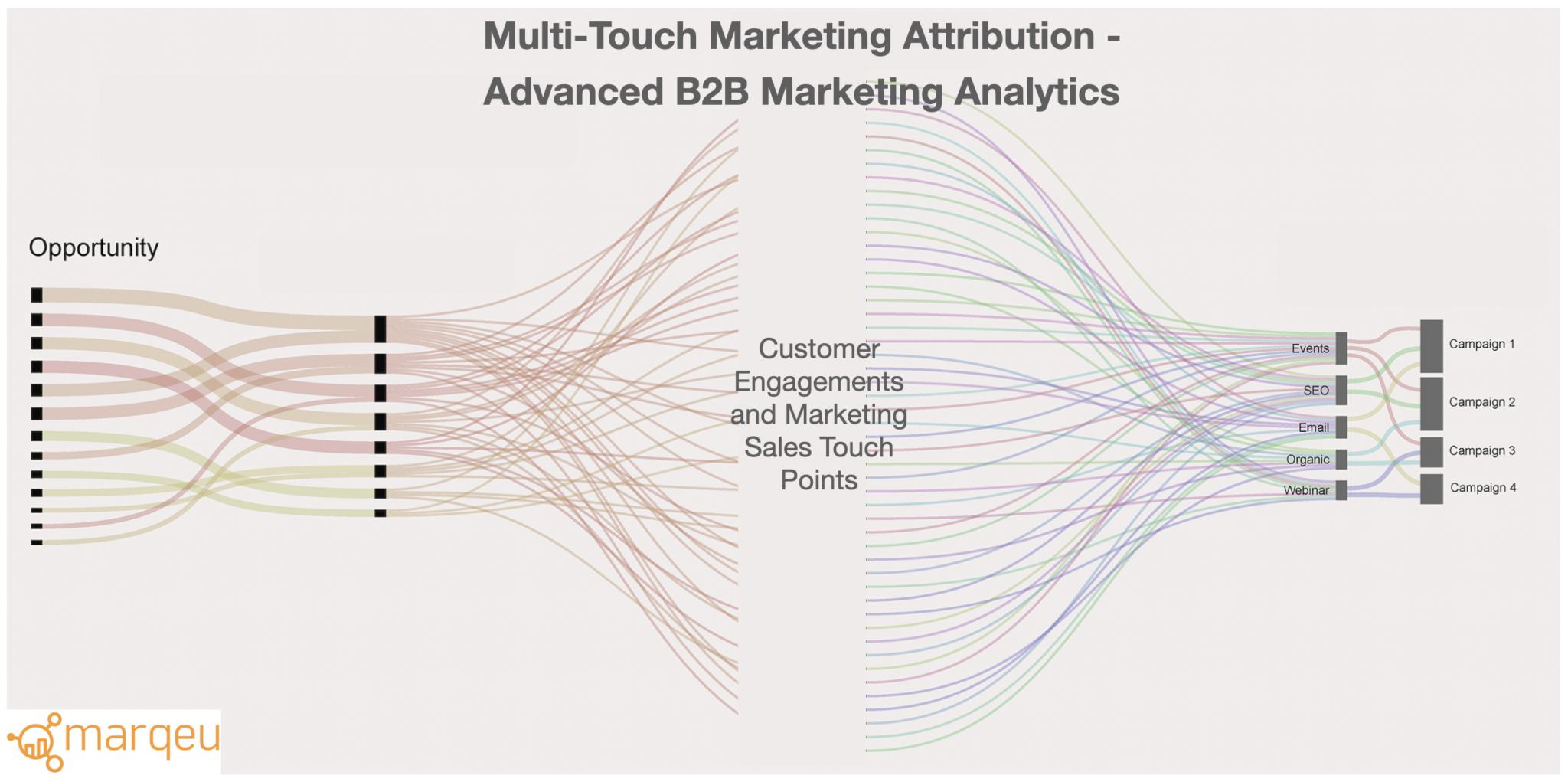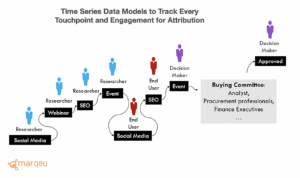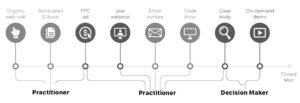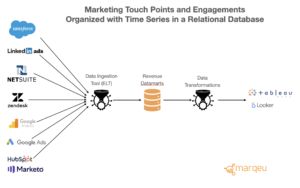
Marketing Attribution – Beginning of a Data Journey
The ability of a marketing organization to track marketing attribution is often considered an end in itself when it comes to advanced marketing analytics. Every marketing leader takes immense pride in talking about the marketing analytics teams at their organizations when they have implemented attribution tools/frameworks and can provide attribution data either via salesforce.com or via in case of more mature analytics teams in platforms like Tableau, Looker, DOMO, etc. Needless to say, marketing attribution is among the elite group of B2B marketing metrics that every data-driven marketing leader likes to track and is widely used across most innovative marketing analytics organizations.
The most common goal and outcome of generally available attribution models/tools is the ability for the revenue (both marketing and sales) teams to track the impact of marketing efforts on generating new pipeline and helping accelerate the existing pipeline.
This is exactly where most of the marketing teams end up dropping the ball. The primary use of the attribution data is mostly limited to tracking how much revenue and pipeline marketing teams are impacting.
We live in a world wherein a multitude of marketing tactics and channels are used by organizations to engage with their customers. Given the connected world we live in and how we gather information, for every closed deal, numerous marketing touches are involved from web engagement (visits, clicks) to email engagement, to webinars, e-books, white papers, in-person events, and the list of possible touches goes on and on. While all these touches have a varying degree of influence on the wins but they all come at a cost and it is not possible for any marketing leader to allocate her budget to these different tactics without some insights into how these tactics perform when it comes to winning those deals. Gone are the days when a marketer could just go by what she “felt” was right.
Given the growing pressure on the marketing teams to continuously justify the spending and deliver higher ROI,
marketing attribution metrics are among the best available metrics to demonstrate marketing’s quantifiable impact on the pipeline.
Finance and sales organizations expect revenue marketing leaders to make data-driven decisions when it comes to budget allocation and also within marketing, the leaders increasingly want to feel confident about these decisions because it is these decisions that will help them meet their pipeline KPIs, the ones on which the success of marketers is increasingly being measured against.
While others see attribution as an end in itself, we see attribution differently.
For us, marketing attribution is more of a framework that opens up the gates to a wealth of information about touch points, marketing engagements, and customer behavior that is very unique to the GTM strategy of an organization.
This data, if synthesized appropriately with key business outcomes in the focus can be leveraged to provide insights for continuously optimizing marketing execution.
From a data analytics perspective, marketing attribution data at its core is nothing more than a framework for tracking every touchpoint across the customer journey.
All these touch points from the very first touch (by sales and marketing teams across various channels) to the last touch (till a deal is closed) are organized in a relational database along with the time stamps for when those engagements happened. These touch points are then further related to the different data sources about campaigns, channels, accounts, opportunities, etc. to provide an enriched data source with comprehensive information that can be further mined to derive key insights into customer engagement behavior and marketing campaign conversions.
Some of the most common marketing use cases that I have implemented by leveraging this enriched data include:
- Aggregating the attribution data over a time period across the deals/opportunities to create a cluster chart/heat map providing visibility into the distribution and conversion across various marketing offers and channels throughout the deal cycle.
- Aggregating the attribution touch points data by different marketing tactics/channels/vendors and combining it with the spend data across different channels (especially digital channels) to track marketing ROI. Remember the questions you get asked from the board like: what was the impact of Facebook ads on pipeline generation last quarter? All those get answered now and on the fly!
- Using the insights from these data clusters to create GTM campaign playbooks for different industries, persona, and especially for ABM campaigns. You are able to see generalizations and best conversion paths around what campaigns and tactics among the marketing mix drive the highest engagements from decision-makers through different channels and different stages of the funnel.
- This attribution dataset provides the richest data with all the marketing engagements and sales touch points laid out in an organized time series format to track the journey of customers throughout the deal cycle along with the details around persona, frequency of engagement at different stages of the deal cycle. These insights are the foundation of customer journey analytics frameworks.
There are numerous companies dedicated to building attribution models for marketing organizations and many such 3rd party tools work some what well especially for very small organizations that are in very early stages of advanced marketing analytics and have a relatively simple GTM strategy. However, my experience across numerous engagements related to attribution modeling has shown that
most of the attribution tools lack one key thing – they are pre-built models with limited options for customization and most of the marketing organizations have to align with how the tools work and measure their performance per the pre-built models only.
I feel that this is a fundamental drawback with out-of-the-box marketing attribution tools with limited options to customize the tools to align them with the GTM strategy of the organizations that end up using them.
At marqeu, we live by the principle that marketing should drive how technology enables and empowers it to be much more impactful and not the other way round.
Across our marketing analytics focused customer engagements, I have seen customers using very rigid attribution models/algorithms that made them change the way they operate or measure their business. In some cases, these tools were customized to align with the business models but given how rigid most of the tools and methodologies are in the first place, they usually cannot withstand too many customizations and breakdown leading to never-ending “maintenance and support” cycle, that leads to nothing but wastage of time and money for the marketers. I am sure many of the enterprise marketing leaders reading have experienced this first hand.
At marqeu, I have been building multi-touch attribution models for the past 8+ years as part of our marketing analytics service offerings for some of the most innovative organizations and this priceless experience has equipped me with unparalleled expertise when it comes to multi-touch attribution. In collaboration with our diverse customer base and phenomenal marketing leaders, I have developed algorithms and frameworks that are easy to implement, understand and more importantly, they empower marketers when it comes to discovering insights about what tactics, channels are driving better returns across the marketing mix and the impact their working is making.
I have designed “a marketing-driven approach to multi-touch attribution” that has a set of guiding principles and parameters as part of this framework.
During our engagements, I review this approach with the marketing teams and further enrich it with the insights that I gather from the marketers around how they operate their business.
When I am fully armed with the knowledge of how a business operates and aligned with the marketing team on how they would like to attribute the pipeline across each of the tactics in the marketing mix, it is then I turn to technology to start building the attribution model
that is designed from the ground-up just to work for the business. Modern marketing analytics/BI (Tableau, Looker, PowerBI, DOMO)/Data Warehousing (BigQuery, Snowflake, Redshift) platforms have made it easy to make sure data from all the platforms across the marketing tech stack is easily accessible in a central database to allow for building highly customized attribution models in a very short amount of time. In this approach, there is no customization or fixing needed as the model is built from the ground-up just around how an organization runs its business.
Think of this approach as making your “own pizza” approach to multi-touch attribution. This approach of letting business drive the technology definition and implementation has been of great success for all our customers.
We are always on the lookout for inputs and examples from the marketing community to keep adding value for our customers. We welcome the inputs from other marketing leaders and analytics practitioners around the approach to attribution in their organizations? What attribution tools you are using and to what extent the attribution data is being used to further build models for advanced marketing analytics use cases?
Subcribe to B2B Marketing Analytics Blog
Recent Posts
- Dynamic Web Scraping with Python, Pandas and DuckDB 05th Mar 2024
- Modern Lead Scoring – The Data Driven Approach 12th Apr 2023
- PLG and Customer Activation – New Paradigm in Marketing Analytics 03th Oct 2022
Recent Comments
- Sales Follow-up and Tracking of the MQLs | marqeu on Conversation Ready Leads
- Sales Follow-up and Tracking of the MQLs | marqeu on Demand Waterfall Conversion Rates – The Framework
- 5 Metrics That Matter The Most In Marketing Analytics | marqeu on ABM – Marketing Analytics Led Demand Generation Engine
- The Revenue CMO - Leading the Data Driven Marketing | marqeu on Growth Marketing – Key Priority for CMOs
- Best of B2B Marketing Zone for October 12, 2020 on Multi-Dimensional Segmentation Engine – Beyond the Smart Lists
Archives
 B2B Marketing Analytics and Marketing Automation
B2B Marketing Analytics and Marketing Automation
- Dynamic Web Scraping with Python, Pandas and DuckDB March 5, 2024The post Dynamic Web Scraping with Python, Pandas and DuckDB appeared first on marqeu.
- Modern Lead Scoring – The Data Driven Approach April 12, 2023The post Modern Lead Scoring – The Data Driven Approach appeared first on marqeu.
- PLG and Customer Activation – New Paradigm in Marketing Analytics October 3, 2022PLG and customer activation powered by advanced marketing analytics capabilities are among the top priorities for all business and growth marketing leaders across B2B SaaS organizations. The primary focus of the marketing analytics work that we have been doing with some of the most forward-looking B2B marketing analytics leaders across SaaS organizations is being augmented[...] […]
- Marketing Attribution – Beginning of a Data Journey April 3, 2022The ability of a marketing organization to track marketing attribution is often considered an end in itself when it comes to advanced marketing analytics. Every marketing leader takes immense pride in talking about the marketing analytics teams at their organizations when they have implemented attribution tools/frameworks and can provide attribution data either via salesforce.com or[...] […]
- Marketing Scorecard – A CMO’s Trusted Advisor October 19, 2021Marketing scorecard powered by a comprehensive marketing analytics frameworks has emerged to be the most trusted advisor of a B2B CMO these days. A well designed and intuitive marketing analytics scorecard provides the much needed at-a-glance view of the health of the marketing organization across 2 broad areas: How well the team is pacing towards[...] […]
- Marketing Analytics and Lead Nurturing – A Strategic Combination August 31, 2021Marketing Analytics and Lead Nurturing is a strategic combination across all revenue marketing organizations. A well-thought-out lead nurture strategy backed by data-driven insights through marketing analytics frameworks is a game-changer. While others see nurturing as a series of emails, we see nurturing differently. For us, nurturing is a data-driven, meticulously planned contextual, and hyper-personalized strategic[...] […]
- Sales Follow-up of the MQLs – Overlooked Part of Marketing Analytics December 14, 2020MQLs are an important part of the marketing analytics frameworks across most of the modern marketing teams but the sales follow-up of the MQLs is critical. Whether it is lead scoring, database management, or reporting around the performance of the MQLs, marketing teams spend a lot of time and energy at continuously optimizing the performance[...] […]
- The Revenue CMO – Leading the Data Driven Marketing November 29, 2020Among the most interesting trends shaping the modern marketing function is the rise of a new breed of the CMOs called the “Revenue CMO”. The role of the CMO has undergone a radical shift especially in B2B technology companies, which are driving the revolution of this new breed of the CMOs. Revenue CMOs are growth[...] […]
- Multi-Dimensional Segmentation Engine – Beyond the Smart Lists October 12, 2020Marketing Analytics is a term that has become synonymous with the success of all modern marketing organizations and database segmentation engine is the key part of marketing analytics. The core competency that differentiates the winning organizations is their ability to objectively evaluate the investments that drive the highest engagement and pipeline growth. Whenever the term[...] […]
- Top 2 Marketing Analytics Priorities for B2B Marketing Teams August 3, 2020As though the ever-increasing expectations of the c-suite from marketing teams to demonstrate the quantifiable impact were not enough and now we are in these unprecedented times, which have further highlighted the need for marketing to be more data-driven and efficient with their investments. Scrutiny around marketing budgets and the asks for returns from the[...] […]




